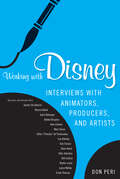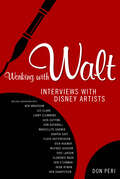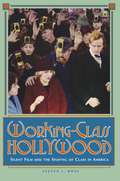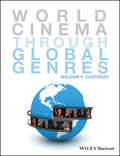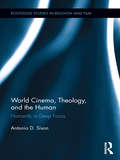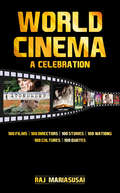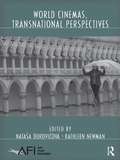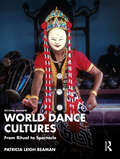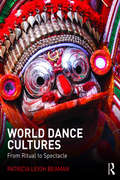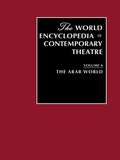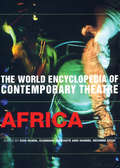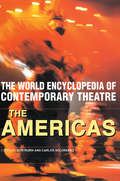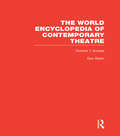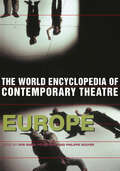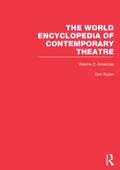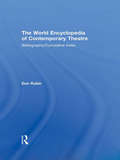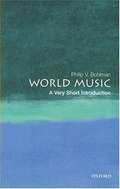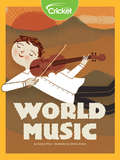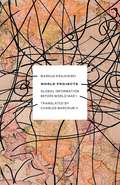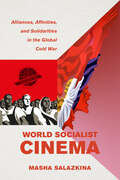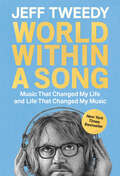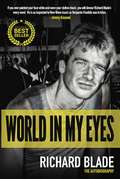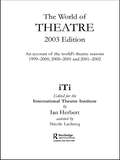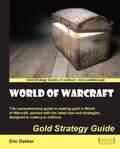- Table View
- List View
Working with Disney: Interviews with Animators, Producers, and Artists
by Don PeriIn this volume Don Peri expands his extraordinary work conducting in-depth interviews with Disney employees and animators. These interviews include conversations with actors and performers rather than solely animators. This book offers Peri’s extensive interviews with Marc Davis, Frank Thomas, and Ollie Johnston, three of Walt Disney’s famed “Nine Old Men of Animation.” Peri interviewed two Disney Mouseketeers—Bobby Burgess and Sharon Baird—from the original Mickey Mouse Club Show, providing valuable perspectives on how the Walt Disney Company worked with television. Lou Debney, a Disney television producer, discusses the company’s engagement with television and live-action film. Walter Lantz talks about his work in the animation business, especially with Oswald the Lucky Rabbit. And Dave Hand discusses his legendary work on Snow White and the Seven Dwarfs. Taken together, the interviews in Working with Disney create an enlightening perspective on the Walt Disney Company as it grew from its animation roots into a media powerhouse.
Working with Walt: Interviews with Disney Artists
by Don PeriThis book includes interviews with Ken Anderson, Les Clark, Larry Clemmons, Jack Cutting, Don Duckwall, Marcellite Garner, Harper Goff, Floyd Gottfredson, Dick Huemer, Wilfred Jackson, Eric Larson, Clarence Nash, Ken O'Connor, Herb Ryman, and Ben Sharpsteen. Walt Disney created or supervised the creation of live-action films, television specials, documentaries, toys, merchandise, comic books, and theme parks. His vision, however, manifested itself first and foremost in his animated shorts and feature-length cartoons, which are loved by millions around the world. Working with Walt: Interviews with Disney Artists collects revealing conversations with animators, voice actors, and designers who worked extensively with Disney during the heyday of his animation studio. The book includes fifteen interviews with artists who directed segments of such classic animated features as Dumbo and Fantasia. Some interviewed were part of Disney’s famed team dubbed “The Nine Old Men of Animation,” and some worked closely with Disney on Steamboat Willie, his first cartoon with sound. Among the subjects the interviewees discuss are the studio’s working environment, the high-water mark of animation during Hollywood's Golden Age, and Disney’s mixture of childlike charm and hard-nosed business drive. Through these voices, Don Peri preserves an account of the Disney magic from those who worked closely with him.
Working-Class Hollywood: Silent Film and the Shaping of Class in America
by Steven J. RossThis path-breaking book reveals how Hollywood became "Hollywood" and what that meant for the politics of America and American film. Working-Class Hollywood tells the story of filmmaking in the first three decades of the twentieth century, a time when going to the movies could transform lives and when the cinema was a battleground for control of American consciousness. Steven Ross documents the rise of a working-class film movement that challenged the dominant political ideas of the day. Between 1907 and 1930, worker filmmakers repeatedly clashed with censors, movie industry leaders, and federal agencies over the kinds of images and subjects audiences would be allowed to see. The outcome of these battles was critical to our own times, for the victors got to shape the meaning of class in twentieth- century America. Surveying several hundred movies made by or about working men and women, Ross shows how filmmakers were far more concerned with class conflict during the silent era than at any subsequent time. Directors like Charlie Chaplin, D. W. Griffith, and William de Mille made movies that defended working people and chastised their enemies. Worker filmmakers went a step further and produced movies from A Martyr to His Cause (1911) to The Gastonia Textile Strike (1929) that depicted a unified working class using strikes, unions, and socialism to transform a nation. J. Edgar Hoover considered these class-conscious productions so dangerous that he assigned secret agents to spy on worker filmmakers. Liberal and radical films declined in the 1920s as an emerging Hollywood studio system, pressured by censors and Wall Street investors, pushed American film in increasingly conservative directions. Appealing to people's dreams of luxury and upward mobility, studios produced lavish fantasy films that shifted popular attention away from the problems of the workplace and toward the pleasures of the new consumer society. While worker filmmakers were trying to heighten class consciousness, Hollywood producers were suggesting that class no longer mattered. Working-Class Hollywood shows how silent films helped shape the modern belief that we are a classless nation.
World Cinema through Global Genres
by William V. CostanzoWorld Cinema through Global Genres introduces the complex forces of global filmmaking using the popular concept of film genre. The cluster-based organization allows students to acquire a clear understanding of core issues that apply to all films around the world. Innovative pedagogical approach that uses genres to teach the more unfamiliar subject of world cinema A cluster-based organization provides a solid framework for students to acquire a sharper understanding of core issues that apply to all films around the world A “deep focus” section in each chapter gives students information and insights about important regions of filmmaking (India, China, Japan, and Latin America) that tend to be underrepresented in world cinema classes Case studies allow students to focus on important and accessible individual films that exemplify significant traditions and trends A strong foundation chapter reviews key concepts and vocabulary for understanding film as an art form, a technology, a business, an index of culture, a social barometer, and a political force. The engaging style and organization of the book make it a compelling text for both world cinema and film genre courses
World Cinema, Theology, and the Human: Humanity in Deep Focus (Routledge Studies in Religion and Film)
by Antonio SisonForging an open-minded but reasoned dialogue between nine acclaimed titles of world cinema, and a range of theological perspectives that touch on the theme of human experience, World Cinema, Theology, and the Human offers fresh portals of insight for the interdisciplinary area of Theology and Film. In Sison’s approach, it is the cinematic representation of vivid humanity, not necessarily propositional statements about God and religion, that lays down a bridge to a conversation with theology. Thus, the book’s project is to look for the divine presence, written not on tablets of stone, but on "tablets of human hearts" depicted on screen by way of audiovisual language. Seeking to redress the interdiscipline’s narrow predilection for Hollywood blockbusters, the book casts its net wider to include a culturally diverse selection of case studies– from festival gems such as Singapore’s Be With Me and South Africa’s Yesterday, to widely-acclaimed sleeper hits such as Britain’s Slumdog Millionaire and New Zealand’s Whale Rider. The book will appeal to scholars of theology and religious/cultural studies interested in the Theology/Religion-Film interface, and, because of its commitment to an examination of film qua film, a crossover readership from film studies.
World Cinema: A Celebration
by Raj MariasusaiA unique collection – entertaining, stimulating, heart-warming and thought-provoking – that brings together a wide variety of films from all corners of the world In this volume, the author declares that ‘watching world cinema is like going around the globe, visiting places and meeting people’. In fact, it opens windows that reveal new vistas, new lands, new cultures and new lifestyles, without ever having to make a single journey abroad! In World Cinema: A Celebration, we come across an assortment of talents that make us experience the complexities of human behaviour in different parts of Planet Earth. The 100 films from different countries (arranged alphabetically and chosen from 1990 onwards) portray the distinct socio-economic conditions prevailing in a particular nation. Here’s a kaleidoscope that offers vivid, fascinating and ever-changing patterns vis-à-vis the moving and talking images.
World Cinemas, Transnational Perspectives (AFI Film Readers)
by Natasa Durovicová Kathleen E. NewmanSCMS Award Winner "Best Edited Collection" The standard analytical category of "national cinema" has increasingly been called into question by the category of the "transnational." This anthology examines the premises and consequences of the coexistence of these two categories and the parameters of historiographical approaches that cross the borders of nation-states. The three sections of World Cinemas, Transnational Perspectives cover the geopolitical imaginary, transnational cinematic institutions, and the uneven flow of words and images.
World Dance Cultures: From Ritual to Spectacle
by Patricia Leigh BeamanFrom healing, fertility, and religious rituals, through theatrical entertainment, to death ceremonies and ancestor worship, the updated and revised second edition of World Dance Cultures introduces an extraordinary variety of dance forms and their cultures, which are practiced around the world. This highly illustrated textbook draws on wide-ranging historical documentation and first-hand accounts taking in India, Bali, Java, Cambodia, China, Japan, Hawai‘i, New Zealand, Papua New Guinea, Africa, Türkiye, Spain, Native America, South America, and the Caribbean, with this second edition adding new chapters on the Pacific Islands, Southern Africa, France, and Cuba. Each chapter covers a certain region’s distinctive dances, pinpoints key issues and trends from the form’s development to its modern iteration, and offers a wealth of study features including: • Spotlights zooming in on key details of a dance form’s cultural, historical, and religious contexts • Explorations—first-hand descriptions by famous dancers and ethnographers, excerpts from anthropological fieldwork, or historical writings on the form • Think About—provocations to encourage critical analysis of dance forms and the ways in which they’re understood • Discussion Questions—starting points for group work, classroom seminars, or individual study. Offering a comprehensive overview of each dance form covered with over 100 full color photos, World Dance Cultures is an essential introductory resource for students and instructors alike.
World Dance Cultures: From Ritual to Spectacle
by Patricia Leigh BeamanFrom healing, fertility and religious rituals, through theatrical entertainment, to death ceremonies and ancestor worship, World Dance Cultures introduces an extraordinary variety of dance forms practiced around the world. This highly illustrated textbook draws on wide-ranging historical documentation and first-hand accounts, taking in India, Bali, Java, Cambodia, China, Japan, Hawai’i, New Zealand, Papua New Guinea, Africa, Turkey, Spain, Native America, South America, and the Caribbean. Each chapter covers a certain region’s distinctive dances, pinpoints key issues and trends from the form’s development to its modern iteration, and offers a wealth of study features including: Case Studies – zooming in on key details of a dance form’s cultural, historical, and religious contexts ‘Explorations’ – first-hand descriptions of dances, from scholars, anthropologists and practitioners ‘Think About’ – provocations to encourage critical analysis of dance forms and the ways in which they’re understood Discussion Questions – starting points for group work, classroom seminars or individual study Further Study Tips – listing essential books, essays and video material. Offering a comprehensive overview of each dance form covered with over 100 full color photos, World Dance Cultures is an essential introductory resource for students and instructors alike.
World Encyclopedia of Contemporary Theatre Volume 4: The Americas (World Encyclopedia Of Contemporary Theatre Ser.)
by Don Rubin (Series Editor)One of the first internationally published overviews of theatrical activity across the Arab World. Includes 160,000 words and over 125 photographs from 22 different Arab countries from Africa to the Middle East.
World Encyclopedia of Contemporary Theatre: Africa (World Encyclopedia Of Contemporary Theatre Ser.)
by Don Rubin Hansel Ndumbe Eyoh Ousmane DiakhatNow available in paperback for the first time this edition of the World Encyclopedia of Contemporary Theatre series examines theatrical developments in Africa since 1945. Entries on thirty-two African countries are featured in this volume, preceded by specialist introductory essays on Anglophone Africa, Francophone Africa, History and Culture, Cosmology, Music, Dance, Theatre for Young Audiences and Puppetry. There are also special introductory general essays on African theatre written by Nobel Prize Laureate Wole Soyinka and the outstanding Congolese playwright, Sony Labou Tansi, before his untimely death in 1995. More up-to-date and more wide-ranging than any other publication, this is undoubtedly a major ground-breaking survey of contemporary African theatre.
World Encyclopedia of Contemporary Theatre: The Americas (World Encyclopedia Of Contemporary Theatre Ser.)
by Don Rubin Carlos SolThis new in paperback edition of World Encyclopedia of Contemporary Theatre covers the Americas, from Canada to Argentina, including the United States. Entries on twenty six countries are preceded by specialist introductions on Theatre in Post-Colonial Latin America, Theatres of North America, Puppet Theatre, Theatre for Young Audiences, Music Theatre and Dance Theatre.The essays follow the series format, allowing for cross-referring across subjects, both within the volume and between volumes.Each country entry is written by specialists in the particular country and the volume has its own teams of regional editors, overseen by the main editorial team based at the University of York in Canada headed by Don Rubin.Each entry covers all aspects of theatre genres, practitioners, writers, critics and styles, with bibliographies, over 200 black & white photographs and a substantial index. This Encyclopedia is indispensable for anyone interested in the cultures of the Americas or in modern theatre. It is also an invaluable reference tool for students and scholars of a wide range of disciplines including history, performance studies, anthropology and cultural studies.
World Encyclopedia of Contemporary Theatre: Volume 1: Europe (World Encyclopedia Of Contemporary Theatre Ser. #Vol. 3)
by Don RubinThe World Encyclopedia of Contemporary Theatre:Europe covers theatre since World War II in forty-seven European nations, including the nations which re-emerged following the break-up of the former USSR, Czechoslovakia and Yugoslavia. Each national article is divided into twelve sections - History, Structure of the National Theatre Community, Artistic Profile, Music Theatre, Theatre for Young Audiences, Puppet Theatre, Design, Theatre, Space and Architecture, Training, Criticism, Scholarship and Publishing and Further Reading - allowing the reader to use the book as a source for both area and subject studies.
World Encyclopedia of Contemporary Theatre: Volume 1: Europe (World Encyclopedia Of Contemporary Theatre Ser.)
by Don Rubin Péter Nagy Philippe RouyerThis new paperback edition of the The World Encyclopedia of Contemporary Theatre: Europe covers theatre since World War II in forty-seven European nations, including the nations which re-emerged following the break-up of the former USSR, Czechoslovakia and Yugoslavia. Each national article is divided into twelve sections - History, Structure of the National Theatre Community, Artistic profile, Music Theatre, Theatre for Young Audiences, Puppet Theatre, Design, Theatre, Space and Architecture, Training, Criticism, Scholarship and Publishing and Further Reading - allowing the reader to use the book as a source for both area and subject studies.A new preface and further reading sections by the Series Editor brings the Encyclopedia bang up-to-date making it invaluable to anyone interested in European theatre, as well as students and scholars of performance studies, history, anthropology and cultural studies.
World Encyclopedia of Contemporary Theatre: Volume 2: The Americas (World Encyclopedia Of Contemporary Theatre Ser.)
by Don Rubin Carlos SolThe second volume of the World Encyclopedia of Contemporary Theatre covers the Americas, from Canada to Argentina, including the United States. Entries on twenty-six countries are preceded by specialist introductions on Theatre in Post-Colonial Latin America, Theatres of North America, Puppet Theatre, Theatre for Young Audiences, Music Theatre and Dance Theatre.The essays follow the series format, allowing for cross-referring across subjects, both within the volume and between volumes.Each country entry is written by specialists in the particular country and the volume has its own teams of regional editors, overseen by the main editorial team based at the University of York in Canada headed by Don Rubin.Each entry covers all aspects of theatre genres, practitioners, writers, critics and styles, with bibliographies, over 200 black & white photographs and a substantial index. This is a unique volume in its own right; in conjunction with the other volumes in this series it forms a reference resource of unparalleled value.
World Encyclopedia of Contemporary Theatre: Volume 6: Bibliography and Cumulative Index (World Encyclopedia Of Contemporary Theatre Ser.)
by Don RubinAn annotated world theatre bibliography documenting significant theatre materials published world wide since 1945, plus an index to key names throughout the six volumes of the series.
World Music: A Very Short Introduction
by Philip V. BohlmanWorld Music draws readers into a remarkable range of historical encounters, in which music had the power to evoke the exotic and to give voice to the voiceless. In the course of the volume's eight chapters the reader witnesses music's involvement in the modern world, but also the individual moments and particular histories that are crucial to an understanding of music's diversity. This book is wide-ranging in its geographical scope, yet individual chapters provide in-depth treatments of selected music cultures and regional music histories. The book frequently zooms in on repertoires and musicians--such as Bob Marley, Dana International, Bartok, and Nusrat Fateh Ali Khan--and attempts to account for world music's growing presence and popularity at the beginning of the twenty-first century.
World Music: Blank Sheet Music Staff Manuscript Paper, 12 Plain Staves Per Page, 130 Pages, 8. 5 X 11
by Donna PriceNiccolo’s parents are professional musicians who play with a symphony orchestra. They want Niccolo to spend the summer playing violin with the youth symphony orchestra. Niccolo enjoys classical music and playing his violin, but after meeting his new neighbors, Jeremy and Melly, he wants to try something different.
World Projects: Global Information before World War I (Electronic Mediations #45)
by Markus KrajewskiMarkus Krajewski is emerging as a leading scholar in the field of media archaeology, which seeks to trace cultural history through the media networks that enable and structure it. In World Projects he opens a new portal into the history of globalization by examining several large-scale projects that, at the beginning of the twentieth century, shared a grand yet unachievable goal: bringing order to the world. Drawing from a broad array of archival materials, Krajewski reveals how expanding commercial relations, growing international scientific agreements, and an imperial monopolization of the political realm spawned ambitious global projects. World Projects contends that the late nineteenth-century networks of cables, routes, and shipping lines—of junctions, crossovers, and transfers—merged into a &“multimedia system&” that was a prerequisite for conceiving a world project. As examples, he presents the work of three big-thinking &“plansmiths,&” each of whose work mediates between two discursive fields: the chemist and natural philosopher Wilhelm Ostwald, who spent years promoting a &“world auxiliary language&” and a world currency; the self-taught &“engineer&” and self-anointed authority on science and technology Franz Maria Feldhaus, who labored to produce an all-encompassing &“world history of technology&”; and Walther Rathenau, who put economics to the service of politics and quickly transformed the German economy. With a keen eye for the outlandish as well as the outsized, Krajewski shows how media, technological structures, and naked human ambition paved the way for global-scale ventures that together created the first &“world wide web.&”
World Socialist Cinema: Alliances, Affinities, and Solidarities in the Global Cold War (Cinema Cultures in Contact #4)
by Masha SalazkinaA free ebook version of this title is available through Luminos, University of California Press’s Open Access publishing program. Visit www.luminosoa.org to learn more. In this capacious transnational film history, renowned scholar Masha Salazkina proposes a groundbreaking new framework for understanding the cinematic cultures of twentieth-century socialism. Taking as a point of departure the vast body of work screened at the Tashkent International Festival of Cinemas of Asia, Africa, and Latin America in the 1960s and 1970s, World Socialist Cinema maps the circulation of films between the Soviet Bloc and the countries of the Global South in the mid- to late twentieth century, illustrating the distribution networks, festival circuits, and informal channels that facilitated this international network of artistic and intellectual exchange. Building on decades of meticulous archival work, this long-anticipated film history unsettles familiar stories to provide an alternative to Eurocentric, national, and regional narratives, rooted outside of the capitalist West.
World Within a Song: Music That Changed My Life and Life That Changed My Music
by Jeff TweedyAn exciting and heartening mix of memories, music, and inspiration from Wilco front man and New York Times bestselling author Jeff Tweedy, sharing fifty songs that changed his life, the real-life experiences behind each one, as well as what he’s learned about how music and life intertwine and enhance each other. <p><p> What makes us fall in love with a song? What makes us want to write our own songs? Do songs help? Do songs help us live better lives? And do the lives we live help us write better songs? <p><p> After two New York Times bestsellers that cemented and expanded his legacy as one of America’s best-loved performers and songwriters, Let’s Go (So We Can Get Back) and How to Write One Song, Jeff Tweedy is back with another disarming, beautiful, and inspirational book about why we listen to music, why we love songs, and how music can connect us to each other and to ourselves. <p><p>Featuring fifty songs that have both changed Jeff’s life and influenced his music—including songs by the Replacements, Mavis Staples, the Velvet Underground, Joni Mitchell, Otis Redding, Dolly Parton, and Billie Eilish—as well as Jeff’s “Rememories,” dream-like short pieces that related key moments from Jeff’s life, this book is a mix of the musical, the emotional, and the inspirational in the best possible way. <p> <b>New York Times Bestseller</b>
World in My Eyes: The Autobiography
by Richard BladeRichard Blade&’s autobiography is much more than a spotlight on any one decade. Instead, he gives you a jaw-dropping, uncensored insider&’s look into the world of music, movies, and television and its biggest stars, starting in the sixties and continuing through to the new century. Richard takes you on a journey that few have experienced: from his early days as a student at Oxford to the wild, lascivious nights of being a disco DJ touring the clubs of Europe, to coming to America and working with Michael Jackson, Barbra Streisand, and Sarah Jessica Parker and finally breaking through into the L.A. radio scene and becoming the number one morning drive personality in California. From his TV and radio shows to his feature films and live gigs, Richard shares stories that have until now remained secret. His unique perspective will take you on the road with Depeche Mode, to Australia with Spandau Ballet, into the recording studio with Morrissey, and onto the main stage at Live Aid with Duran Duran. He opens up about his friendships with Michael Hutchence and George Michael, as well as his passionate love affair with Terri Nunn of Berlin. This is a no-holds-barred look at life, sex, and death, set to a pulsing backbeat of music. For the first time, Richard Blade shares his extraordinary story, allowing us to see the world through his eyes.
World of NEXO KNIGHTS Heroes (LEGO NEXO KNIGHTS)
by Kate HowardIt takes a special hero to join the NEXO KNIGHTS(TM) team! In this official guide you'll meet the NEXO KNIGHTS heroes, discover the history of Knighton and the Cloud of Monstrox, explore the knights' newest, gear, learn all about their shields enemies, vehicles, weapons, and more! If that wasn't enough, you'll also get a sneak peek at what's next for the heroes of Knighton. Plus, it includes a scanable Forbidden Power! It's everything you wanted to know about the NEXO KNIGHTS heroes!
World of Theatre 2003 Edition: An Account of the World's Theatre Seasons 1999-2000, 2000-2001 and 2001-2002
by Ian HerbertEdited by Ian Herbert, President of the International Association of Theatre Critics, Secretary of the Drama Section of the Critics' Circle in London, and editor of Theatre Record, the chronicle of the British stage, and Nicole Leclercq, Archives et Musée de la Littérature, Brussels, the World of Theatre is a lavishly illustrated biennial publication providing on-the-spot and authoritative surveys of current theatrical activity from across the globe. The content of the book is as varied as the theatrical situations it describes, from magisterial round-ups by leading critics in Europe to desperate and pitiful reports from the battlefield in war-torn countries.With expanded coverage, this new edition encompasses the three seasons from 1999 to 2002 and contains articles from over seventy countries. The contributors include leading commentators such as Jim O'Quinn, editor of American Theatre, and England's Peter Hepple, the longest serving London theatre critic and a former editor of The Stage.The World of Theatre will be welcomed by theatre scholars as an ongoing revision of another Routledge reference work, the World Encyclopedia of Contemporary Theatre and is essential reading for anyone seeking up-to-date information on the developments in the leading theatre nations as well as those countries whose theatre is little known outside their boundaries.
World of Warcraft Gold Strategy Guide
by Eric DekkerRich with examples, detailed breakdowns, and step-by-step instructions, this book gets down to the nuts and bolts of gold making, to help you become a World of Warcraft gold tycoon.This book is for every World of Warcraft player who's tired of scrapping for gold or has ever wanted to be the one showing off expensive items in town.
